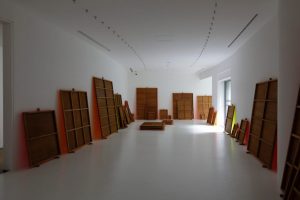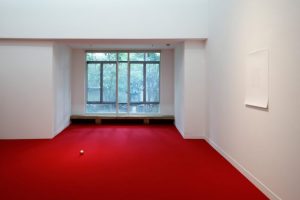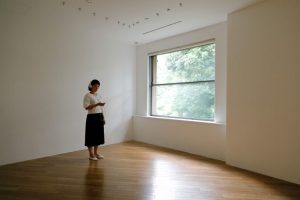Contents
Exhibitions
Mercedes-Benz Art Scope 2018-2020
Dates : July 23 (Thursday/national holiday) – September 6 (Sunday), 2020
*A reservation is required to visit the museum.For details about the reservation-based admission system, please click
here .
*One exhibit requires the use of earphones. Visitors, if possible, are requested to bring their own earphones or headphones.
The Hara Museum of Contemporary Art is delighted to present Mercedes-Benz Art Scope 2018-2020. Since 2003, the Hara Museum has partnered with Mercedes-Benz Japan in the Art Scope artist-in-residence program which invites young artists from Japan and Germany to live in and draw inspiration from a different cultural environment. In 2018, the Japanese artist Tsuyoshi Hisakado was sent to Berlin for the 2018-2020 program and from Germany, the Cypriot artist Haris Epaminonda was sent to Tokyo in 2019. These two, as well as a previous Art Scope participant, Meiro Koizumi (Berlin, 2010), come together in this exhibition to present their latest creations, produced under the challenging constraints, both social and physical, of the current health crisis facing humanity.
Highlights
Tsuyoshi Hisakado has been drawing increasing attention for installations that incorporate samples collected of everyday phenomena, memories retained by particular locations and historical events and transformed into fragments of sound, light, and sculpture. Last year, his collaborative work with Apichatpong Weerasethakul debuted at the 58th Venice Biennale. The same year saw the staging of his first theater work Practice of Spiral. In March 2020, Practice of Spiral, his first large-scale solo exhibition in Japan, opened at the Toyota Municipal Museum of Art. For this exhibition, Hisakado, in his usual fashion of engaging in a dialog with a given space to find inspiration, has created an installation in the museum’s Gallery II that takes advantage of its unique configuration − a gentle arc that seems to enclose the outer garden. Within the gallery space Illuminated only by natural light, the artist uses glowing colors and sound to engage and ratify the senses.

Haris Epaminonda uses the technique of collage in her film/video works and installations. She became a focus of international attention at the 58th Venice Biennale last year when she was given the Silver Lion for a Promising Young Participant. As a long admirer of Japanese culture that began with an interest in the Japanese film director Yasujiro Ozu, Epaminonda, on her maiden visit to Japan to take up her residency last summer, chose to reside in both Tokyo and Kyoto. In this exhibition, she has collaborated with the German artist Daniel Gustav Cramer in a work entitled Untitled #01 b/l which takes as its theme the music of Hiroshi Yoshimura, an artist closely associated with the Hara Museum in the past. She also presents a video work Japan Diaries that she made on Super 8 film during her stay in Japan and digitized for this exhibition.

Meiro Koizumi is known for works that use theatrical techniques to highlight the relationship between humans and humans, between humans and society, and between words and the body. In recent years, he has also been creating artwork that uses VR (virtual reality) technology. At the Aichi Triennale last year, Koizumi made a big splash with the premier of Prometheus Bound, his first theater piece using VR technology. In this exhibition, he is presenting Anti-Dream #1 (Room with a Sculpture), a sound sculpture that requires visitors to listen to sounds while moving between two gallery spaces, and Anti-Dream #2 (Statues for the Celebration) for which visitors download and listen to an audio file while in the city (URL:
https://www.meirokoizumi.com/anti-dream2dl).

Participating Artists
Tsuyoshi Hisakado
Born in 1981 and lives in Kyoto, Hisakado received an M.F.A. in sculpture at Kyoto City University of Arts in 2007. His major exhibitions in recent years include Aichi Triennale 2016, Culture City of East Asia 2017 Kyoto: Asia Corridor Contemporary Art Exhibition, MAM Project 025 (Mori Art Museum, Tokyo, 2018) and the 58th Venice Biennale International Exhibition May You Live in Interesting Times. In 2016, he created the stage design for chelfitsch’s Time’s Journey Through a Room which was performed worldwide. In 2019, his debut theater work Practice of Spiral was staged at ROHM Theatre Kyoto as part of the Kyoto Experiment: Kyoto International Performing Arts Festival. Hisakado’s first large-scale solo exhibition in Japan Practice of Spiral opened at the Toyota Municipal Museum of Art in March 2020.
Haris Epaminonda
Born in Nicosia, Cyprus in 1980 and lives in Berlin, Epaminonda studied at the Royal College of Art and Kingston University in England. In 2013, she was one of four artists shortlisted for Germany’s preeminent art prize, the Preis der Nationalgalerie. She represented Cyprus at the 52nd Venice Biennale in 2007 Old earth, no more lies, I’ve seen you … and the 58th Venice Biennale May You Live in Interesting Times where she won the Silver Lion for a Promising Young Participant. She has also contributed to many other international exhibitions such as the Berlin Biennale (2008) and dOCUMENTA 13 (2012) in Kassel, Germany. In Japan, she participated in the group exhibition The Kaleidoscopic Eye: Thyssen-Bornemisza Art Contemporary Collection at the Mori Art Museum in 2009.
Meiro Koizumi
Born in Gunma, Japan in 1976 and lives in Yokohama, Koizumi graduated from International Christian University and studied at Chelsea College of Art and Design (London). His past solo exhibitions include MAM Project 009 Koizumi Meiro at Mori Art Museum, Tokyo (2009), Projects 99: Meiro Koizumi at The Museum of Modern Art, New York (2013), Trapped Voice Would Dream of Silence, Arts Maebashi, Maebashi, Japan (2015) and Battlelands at Perez Art Museum Miami (2018). Group shows include Art Scope 2009-2011: Invisible Memories, Hara Museum of Contemporary Art (2011), Future Generation Art Prize 2012, Pinchuk Art Center, Kiev (2012), Demarcation, Ginza Maison Hermès Le Forum, Tokyo (2015), the 12th Shanghai Biennale (2018) and Sharjah Biennial 14, UAE (2019). His works are included in numerous collections all over the world. His VR-incorporated theater work Prometheus Bound was presented at Aichi Triennale 2019.
- Dates
July 23 (Thursday/national holiday) – September 6 (Sunday), 2020
- Organized by
Hara Museum of Contemporary Art and Mercedes-Benz Japan Co., Ltd.
- Under the auspices of
Embassy of the Federal Republic of Germany in Japan
- Cooperation provided by
HOLBEIN ART MATERIALS INC.
- Cooperation and residency program coordination provided by
Arts Initiative Tokyo [AIT]
- Hours
weekdays 11:00 am – 4:00 pm /weekends until 5:00 pm
Please note that weekday hours have been shrtened and there will be no evening hours on Wednesday.- Closed
Mondays (except August 10) and August 11
- Admission
General 1,100 yen; Students 700 yen (high school and university) or 500 yen (elementary and junior high); Free for Hara Museum members and students through high school every Saturday during the school term
Related Event: AIT ARTIST TALK #79 with Meiro Koizumi and Tsuyoshi Hisakado
http://www.a-i-t.net/ja/future_archives/2020/08/artisttalk79.php
*This event will be held in Japanese.
*Please note that the exhibition period and starting date are subject to change depending on the Covid-19 situation.